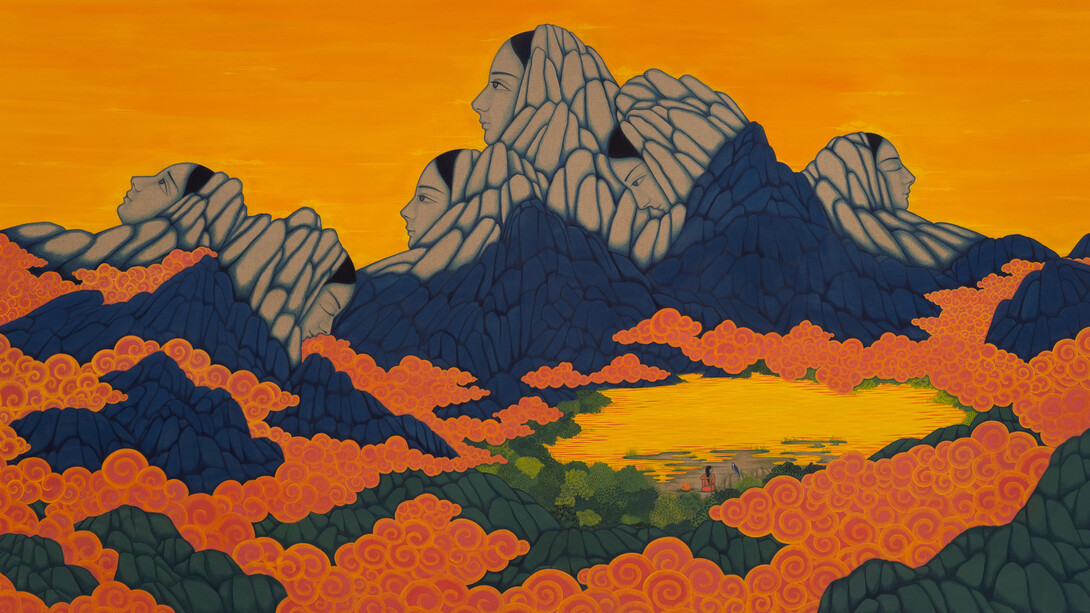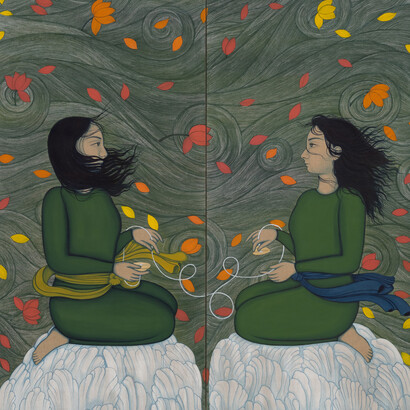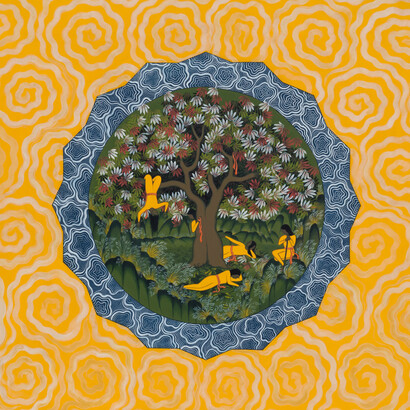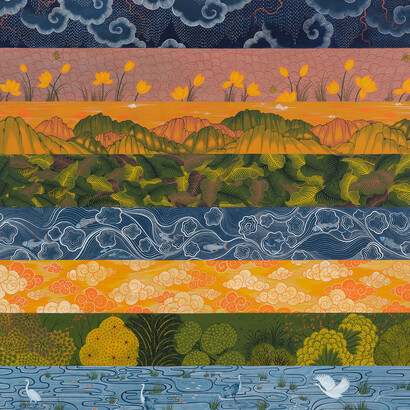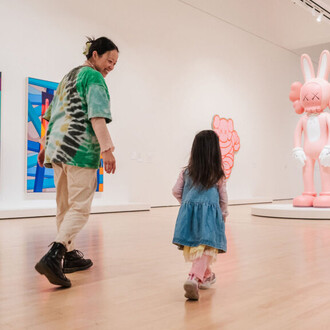Jessica Silverman is delighted to present The eighth color by Rupy C. Tut, a solo exhibition of paintings on linen and handmade paper that explores cultural history, feminine agency, and ecological dreamlands. A polyglot who speaks English, Hindi, Urdu, Punjabi, and Spanish, Tut often reflects on the experience of migration and the psychology of diaspora. The exhibition’s title pays homage to one of Tut’s heroes, pioneering poet Amrita Pritam, who describes “the eighth color of love” as a spiritual passion for the equality of humankind as a whole. The exhibition, running from October 30 through December 20, is Tut’s second with Jessica Silverman and first in the main space.
At nine feet wide by five feet high, Six grandmothers and the falcon (2025) is a majestic painting that challenges the colonial and patriarchal biases of most historical monuments. Mount Rushmore, which honors four American Presidents, was carved into the face of a South Dakota mountain sacred to the Lakota Sioux, who called it the “Six Grandfathers,” after the six granite outcrops that once lined its peak. The land was guaranteed to the Lakota people under an 1868 Treaty, but when gold was discovered in the hills, the American government seized it—an act later deemed illegal by the U.S. Supreme Court.
In another large-scale work titled Tune in (2025), the wind swirls around two women whose eyes are locked in peaceful contact. Each of them holds a single devotional cymbal that, when struck together, produces a bright, ringing sound. The wind howls through the unshackled hair of the figures, which is rendered in three precise layers of pure indigo. Their wayward strands evoke a refreshing blast of wildness or a liberating gust of good news. Indeed, in many Middle Eastern and South Asian cultures, the wind or “hawa” is a metaphor for change—whether it’s climatic, social, or political.
While cummerbunds serve as a sartorial motif in four of the show’s paintings, they become characters in States of inner conflict (2025). In this audaciously composed painting, two women or two facets of the same woman wrestle with all their might, radiating fiery energy into their surroundings. Their cummerbunds fly out from their combined core like animated creatures or the extra limbs of an Indian Goddess. Though not quite phallic, Tut’s cummerbunds are symbols of potency; they speak to the complexities of empowerment and the struggles of desire.
The works in the show are created using a limited palette of eight natural colors, made by the artist from various minerals—zinc oxide (white), ground silver leaf, cinnabar (red), minium (bright orange), realgar (yellowy orange), yellow lead oxide, verdigris (turquoise)—and one plant, indigo (deep blue). This labor-intensive approach to materials is part of a thoughtful ritual rooted in the Himalayan tradition of miniature painting that Tut studied for eight years. By these means, Tut creates works featuring both significant detail and contemporary American “wall power.”
Old trees are central to at least three pieces in the exhibition – Sweet mango, sweet maple, and the blue planet (all 2025). A symbol fundamental to many cultures, trees often represent wisdom, strength, beauty, and longevity. Rooted in the earth but reaching above human heads, they connect the material and the ethereal, narrating a relationship between past, present, and future. In The blue planet, a cool green paradise with a blooming tree is protected from a hot, yellow atmosphere by a deep moat of blue sea. Around the tree are five women, who could be Eves or college students on a lunch break. Whatever their identity, they share a belief in the virtues of knowledge and the benefits of stillness. Indeed, the painting is a mandala or portal for relieving stress, improving focus, regaining balance, enhancing awareness, and gaining clarity.
Against this complex history, Tut creates an image of durable, public commemoration, which asserts the historical significance of women, and specifically her South Asian grandmothers, through whom she acquired her Sikh ethics—values such as honesty, meditation, equality, justice, humility, and service to others—and developed her understanding of her Punjab homeland as a religious and ethnic crossroads. “I grew up knowing that home was many places,” explains Tut. “But that doesn’t stop me from painting imaginary homelands where we can have heightened ecological awareness and greater sovereignty. Knowing so many people on this planet are fighting against erasure gives me the courage to champion it for my own people and gender.”
Tut is not just an innovative painter but also an ambitious mythologist whose works depict alternative legends that point toward nobler futures. Her female figures demand attention and cultural authority long denied to women of color. Her landscapes are environmental havens—both sanctuaries and sacred spaces—that offer themselves as potential destinations. Collectively, Tut’s work reflects her vision of transformation—where spiritual dedication to equality and justice is manifest in pictures that resonate across continents.
